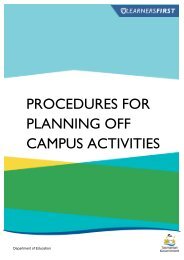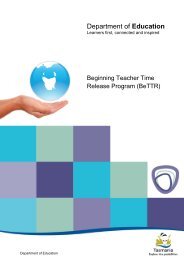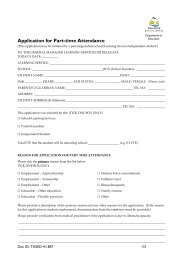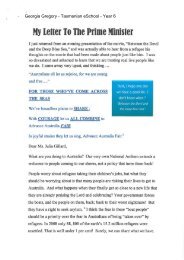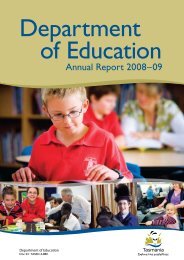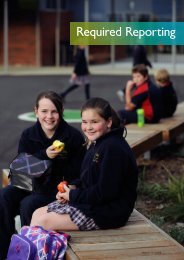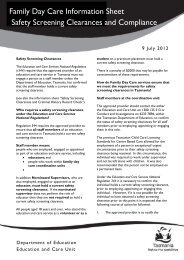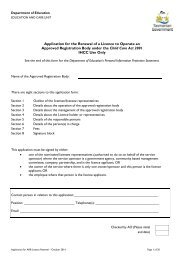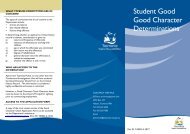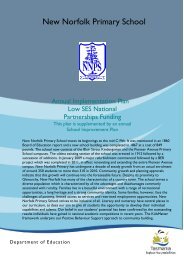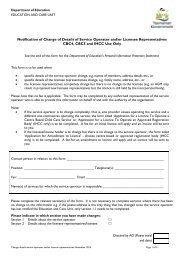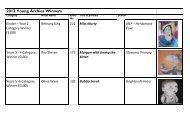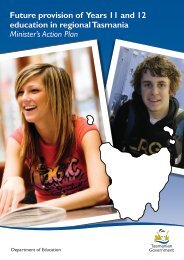Tas Curriculum K-10 - Languages - Italian - Department of Education
Tas Curriculum K-10 - Languages - Italian - Department of Education
Tas Curriculum K-10 - Languages - Italian - Department of Education
You also want an ePaper? Increase the reach of your titles
YUMPU automatically turns print PDFs into web optimized ePapers that Google loves.
Focus on:<br />
identity<br />
relationships<br />
belonging<br />
stereotypes<br />
• form and structure <strong>of</strong> language<br />
Learning opportunities standard five<br />
• applying rules and language patterns to unfamiliar language situations<br />
• using a range <strong>of</strong> strategies and tools appropriately<br />
• diverse range <strong>of</strong> text types and media<br />
• range <strong>of</strong> audiences, contexts and purposes<br />
• longer conversations<br />
• more complex written texts<br />
• growing independence in use <strong>of</strong> language<br />
• global issues<br />
• self and country<br />
• exchanging places e.g.<br />
student exchange,<br />
travel<br />
• cultural icons e.g.<br />
famous people and<br />
places<br />
interactions<br />
respect<br />
responsibility<br />
diversity<br />
Key concepts and topics<br />
• restaurant / catering<br />
• news / popular<br />
media<br />
• making connections<br />
e.g. email, SMS<br />
Linguistic items<br />
Bold indicates pre-tertiary entry content.<br />
Everyday language<br />
Conversations within familiar contexts<br />
Intonation and Pronunciation<br />
Shortening <strong>of</strong> vowel sound before a double<br />
consonant eg. gatto<br />
Developing a good flow when reading<br />
Adjectives<br />
All forms <strong>of</strong> possessives e.g. il vostro, il loro<br />
Demonstrative e.g. questo, quello<br />
Recognition <strong>of</strong> comparative e.g. piu’<br />
buono, meno di, uguale a, meglio di, un<br />
migliore studente, peggiore, maggiore,<br />
minore<br />
Recognition <strong>of</strong> superlative e.g. il / la<br />
migliore, il / la peggiore, il / la minore<br />
Variable interrogatives e.g. quale / i?<br />
quanto / a / i / e? + noun<br />
Adjectives ending in -ista and their plurals<br />
e.g. ottimista<br />
environment<br />
lifestyle<br />
wellbeing<br />
sustainability<br />
• housing<br />
• climate<br />
• recreation<br />
tradition<br />
celebration<br />
culture<br />
change<br />
• texts e.g. songs,<br />
poetry, stories,<br />
plays<br />
• cultural practices<br />
e.g. family, religion,<br />
food<br />
Possible teaching emphases<br />
• Provide opportunities for students to survey<br />
class members about their eating habits and<br />
write a brief report on the findings (e.g. the<br />
majority / some / a few / most / a number <strong>of</strong><br />
/… per cent, prefer …) displaying the results<br />
on a chart or graph and reporting orally on<br />
ways the class could improve their health.<br />
• Use contemporary music lyrics in the target<br />
language to identify issues relating to target<br />
language youth culture and contribute to a<br />
class concept map.<br />
• Have students observe and listen to a recipe<br />
being prepared and described in the target<br />
language to identify steps and processes<br />
involved e.g. recognises language items such as<br />
‘firstly’, ‘secondly’, ‘and then’, ‘finally’, ‘we<br />
need’, ‘you must / must not’, ‘remember to’,<br />
‘don’t forget’.<br />
62




